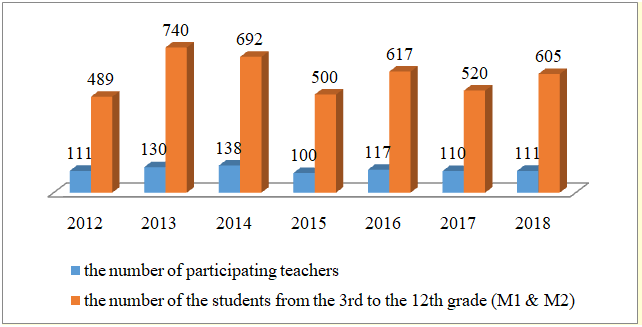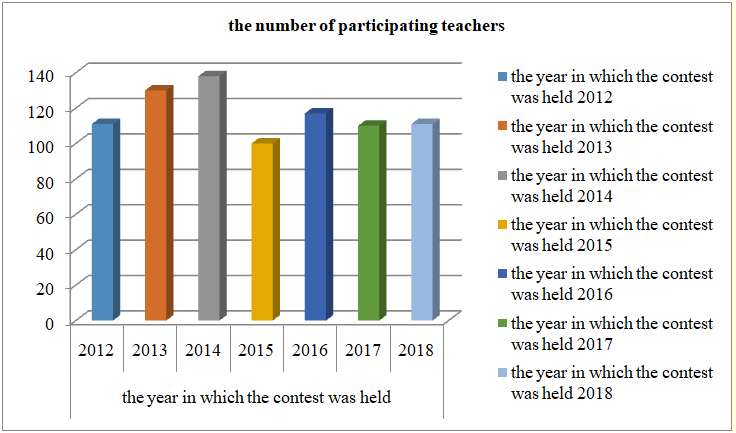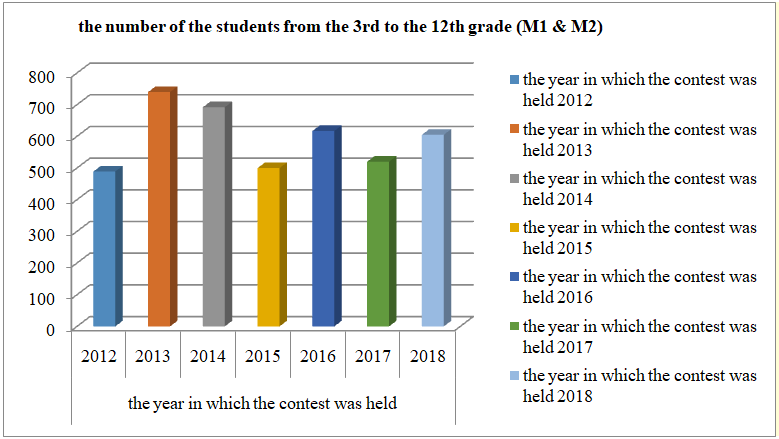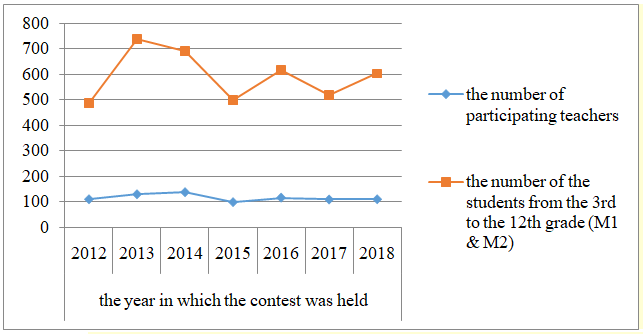Abstract
In this paper we aim to highlight and, also, to share from our experience, the one of the main organizers of the national mathematics contest „Magic of the Numbers”, intended for pupils from the third grade to the 12th grade, at the both M1 classes and M2 classes. In this competition, the University of Pitesti, more precisely, Education Sciences Department, is a partner, alongside School Inspectorate of Olt District (ISJ Olt) and the thirty other schools from the fifteen counties of the country. By the modern aspect of organizing this contest, we mean the collaboration between all the participating math teachers for the design the templates of assessment items, the emailing them in the contest day at each contest center for being open, and so it is building of network consisting of all the contest centers which are distributing through the country. Also, we want to highlight the benefits of this kind of collaboration and professional communication between the math teachers on the mathematical contents of this contest, which are proposed to the students. The participating students in this contest have the opportunity to learn what perseverance, patience and responsibility means. For the students of the terminal classes of the scholar cycles, this contest is also an opportunity for their self-acquiring math knowledge before the national evaluations, the capacity examines and baccalaureate examines, because for these students, the subjects of the contest are according to the models which are proposed by National Education Ministry (M.E.N.)'s evaluations.
Keywords: Mathematics educationmathematics contestMathematics Olympiadschool success
Introduction
In general, the school competitions are viewed as an important part of the educational activities beyond the curriculum for the gifted and talented students, or for giving the chance to all students to compare their own learning acquisitions with other colleagues’ achievements, and part of the recommended continuum of differentiated opportunities of Ministry of National Education.The most commonly organized scholar competitions were in the domains such as mathematics, physics, chemistry, literature, music, arts, physical and sport abilities,etc. “The primary goals of mathematics competitions are to increase motivation, excitement and interest in mathematics, and to provide schools and parents with information about more able students. A competition result provides one measure of a student’s mathematical ability and discriminates ability levels of individuals at the participant’s level. Preparation for a competition in mathematics may demand targeted independent study as many competitions require rapid and accurate answers under pressure. Some competitions in mathematics, such as those organized by local mathematics teachers’ associations, include group problem solving activities where team work and collaboration are important. However, most competitions rely on independent problem-solving abilities” (Bicknell, & Riley, 2012). The International Mathematics Olympiad is considering „an international supremacy” of the National Mathematics Competitions (National Mathematics Olympiads) and is an opportunity at the Mondial level for finding out the most talented and creative high school students which have focused on the activities of learning mathematics because of the miscellaneous personal reasons. The International Mathematical Olympiads have a tradition longer than one hundred years, and the first mathematical competitions were organized in Eastern Europe (Hungary and Romania) by the end of the 19th century. In 1959 the first International Mathematical Olympiad was held in Romania, where seven countries, with a total of 52 students, attended that contest (Andreescu & Enescu, 2011) The “story” of the International Mathematical Olympiads continues and will be continued even in the future society of the “artificial intelligent”. Numerous math competitions organized at the level of every country in the world, at the continental or international levels, sustained and sustained concerns of all world organizations dealing with educational policies in which mathematics teaching is given great importance, etc. are, perhaps, the concerns for ensuring the continuity of the youth human resource for the development of the mathematics which will be necessary for the future human society.
In this framework, in 2009 Iuliana Traşcă together with a little group of her mathematics teacher colleges from Olt district, Delia –Ileana Naidin-Basch, Luminiţa Floricel, Mariana Aura Benescu, etc., initiated an educational project called “Magic of the Numbers” in collaboration with the Bogdan N. Nicolescu and Tudor C. Petrescu from the Education Sciences Department of the University of Piteşti. During of nearly ten years, this project has become a mathematical contest whose status has evolved from an inter-district level at a regionally one, being recognized in the timetable of the contests and recommended by the Ministry of National Education.
Problem Statement
From the beginning of the history of the “Magic of the Number Mathematics” Competition, i.e. the 2009-2010 school year, we can note that this was only an educational project that aimed to stimulate students' learning interest for the mathematics and the sciences through various curricular and extracurricular activities where students would be involved (Traşcă, 2011). The purpose for organizing such an educational project was to include as many school communities from Romania, as partners of this project, in the mathematics activities for their students such as they want to learn for become better. By the other hand, the aim of this educational project was to improve the quality of the educational act of the teachers both in the mathematical discourse and in the other science disciplines (physics, chemistry, biology, etc.), through recreational and relaxing activities which can take various organizational forms, e.g. resolving of encirclements, enigmas, paradoxes, tricks, etc., involving mathematics and, implicitly, the formulation of math problems that students have to solve.
Among the objectives of the Magic of Numbers project we mention:
revealing the mathematics knowledge and the connections with the concepts specific to disciplines in the curriculum of sciences, which necessarily and implicitly led to the introduction of the mathematical concepts;
encourage and stimulate students' interest in learning maths and sciences within the holistic paradigm of the 21st century education policies;
encouraging innovation and creativity in the teaching of mathematics, science and technologies;
development of collaboration relations between students, teachers and, implicitly, between educational units from Romania;
developing communication skills between the students from the different schools in the virtual environment (using the new ICT technologies);
developing communication skills of the students in a wide-ranging language such they will be able to promote collaborations with the students from other EU countries and beyond;
improving the team work skills for the students;
promoting a European spirit amongthe students, etc.
The target group of the „Magic of the Numbers” project consists by the students of aged between 9 and 18 years, so that it can cover for all the three cycles of the national education system: primary, secondary and high school.
Among the activities proposed by this educational project we mention:
improving the team work skills for the students;
students’ pre-preparation for the national mathematics assessment;
promoting a European spirit among the students, etc.
Last but not least, it was intended to build a sustainable network for the professional communication between mathematics teachers from all the Romania’ s districts for ensuring their collaboration on major themes in the field of mathematics didactics, mathematics teaching, national mathematics curriculum, mathematics textbooks and other math auxiliaries, etc.
In fact, this link between partner teachers naturally derives from the way in which the competition is organized, because each of them proposes subjects for the written test of the competition and corresponding scales for their evaluation and marking for any class starting to 3rd grade to 12th grade (M1 and M2). All of this is electronically transmitted to the contest president at least two months before the date on which it takes place. At the end of the centralization of these documents, the president selects them in view of distributing to a certain grade, such that as many possible partner teachers can to contribute as promoter of subjects of every test of contest. In plus, each of test of contest of either one grade has to be balanced correctly from the point of view of the difficulty of solving of all its items, and these covers as much possible the learning mathematical contents from the curriculum. After this stage, the contest subjects and their evaluation scales are shaping in the contest templates, and then two zipped and passworded documents are made. These are sent to each organizing contest centre from each district, and on the day of the contest one hour before the actual start of the contest it is sent the password of the zipped tests for opening, printing and for the distribution of the contest tests to the students which participate at the contest. Obviously, once the written test has begun, the password of the archived document with the correction and scoring scales are sent to each organizer's centre for printed and displayed for consultation by the participating students at their exit from the examination room. The participate students’ works are corrected in the organizing centre, by an evaluation committee made up of mathematics teachers from suitable district, then the results are centralized by the committee of this centre. The final lists with the participate students' contest results are sent to the contest president, who makes the final hierarchy of the candidates by these results.
We must emphasize that each participating student receive a diploma of participating at „the Magic of the Numbers” mathematics contest. This diploma is signed by the project manager, by the contest president, and by the general inspector and mathematics inspectors from the School Inspectorate of Olt District. Also, each mathematics teacher receives either an attestation of proponent teacher of math problems at the contest, or an attestation as student's companion teacher at the contest, or an attestation as the evaluation teacher of the students' papers at the contest. All diplomas and attestations are printed from the „Magic of the Numbers” educational project's funds, so that there are not participation fees for the participating students and teachers at this mathematics contest (National College Mihai Eminescu, 2017).
Last but not least, we must underline that all the results of the contest are being broadcast on the communication network space of the educational project “the Magic of Numbers”. On this web site, the discussions and suggestions there are place between the participation teachers to improve their mathematics education topics involved in the training activities for the students, to promote the good practices of teaching mathematics and to self-evaluate the teachers' performance to improve the students' mathematics learning.
Research Questions
After almost a decade of existence of mathematics contest “The Magic of the Numbers” we have to ask ourselves a few natural questions: What did we achieve with all our activities for the students and for the community of mathematics teachers? What are the effects of our educational activities on the „philosophy” of the national mathematics contests? How we have to continue this mathematics contest? There are some things which we have to change or to improve them? Is our mathematics in the “philosophy” of mathematics for the all students? (Damerow, Dunkley, Nebres, & Werry, 1984). To answer some of these questions, we had to made a correct analysis of our data base built over the „life” of the „Numbers Magic” mathematics contest.
Purpose of the Study
It is true that in general the primary goals of mathematics competitions are to increase motivation, excitement and interest in mathematics, and to provide schools and parents with information about more able students. Also, it is assumed that a competition result provides one measure of a student’s mathematical ability and discriminates ability levels of individuals at the participant’s level (Bicknell & Riley, 2012). In the frame on these ideas, we started initially to project our mathematics context “The Magic of the Number”. We did not consider the necessity of the extra mathematics preparation for the participated students at the “The Magic of the Number” contest. From the beginning, within frame of the previous ideas, we thought that the contest as an opportunity as any pre-university student aged 9 and 18 would be able to participate to this contest for self-evaluation of his/her mathematics competences which he/she which he/she has acquired on the basis of its classroom training. In addition, the contest is an opportunity for both partner and organizing teachers to evaluate their classroom work through the results of their students at this math contest. So, the purpose of our study is related to a kind of achievements balance sheet of the math contest over the nine years of its existence.
Research Methods
The main research method used is the statistical analysis of the database obtained during the nine years of the mathematics contest „The Magic of the Numbers”, mainly following the dynamics of several indicators, as:
the number of students participating in this contest;
the number of teachers proposing subjects for the competition;
the number of evaluator teachers involved volunteer in this activity;
the number of schools participating in this project based on the partnership agreements between them and the director of the educational project “The Magic of the Numbers”.
We did not intend to compare our results with results obtained in other similar math competitions in the country or other countries. So, the analysis method is just about interpreting data from our database built between 2012-2018.
Findings
We must admit that in the first two editions of the “The Magic of the Numbers” mathematics contest, i.e. in the years 2010 and 2011, our „science” in keeping archival the database of the contest was still in “training”. In other words, we could not use this sequence of the first two years in our statistical analysis. Thus, in Table
First of all, we have to note that the number of participating students and the number of teachers involved as partners of the competition based on a contract of collaboration increased from 2012 to 2018. It is true that this increase did not it was smooth, there were years when we had a smaller participation, such as 2015 and 2017. Secondly, we can say that during the nine years of the competition a group of teachers was formed which is already a force in the collaboration of mathematics teachers in the country. This group discusses both the results of the contest, the way in which the competition issues were solved by the participating students, the representativeness of the proposed topics from the perspective of the contents of the math programs, etc. Thirdly, we can see that some of the students had been participating in this competition for three years or four consecutive years. What is an indicator for us that their interest and motivation have been stimulated by the way this contest is organized. We have not to be haughty, so we must admit that this is also due to the dedication of their math teachers to the education of these students
Below the graphical representations of the data presented in Table




All the above achievements encourage us to continue „The Magic of Numbers” educational program, and in the centenary year 2019 to organize a national symposium on innovative methods in mathematics didactics. From these experiences the mathematics should learn for tomorrow to teach mathematics for their students in the classroom in the better ways.
Conclusion
From our point of view, without the lack of modesty, this project is a success, because this true sentence deriving from the interest shown by both math teachers and students participating in the mathematics contest “The Magic of the Numbers”. Based on the data collected, one can also see an interest on this contest through the increasing number of the district’s scholar inspectorate and the educational unities which are involved in partnership agreements within the educational project „The Magic of the Numbers”. As a matter of fact, the participating students also expressed their view on this math contest, motivating their participation at this mathematics contest as a great opportunityfor helping them for the national evaluation exam or baccalaureate by the nature of the contest test. It is remarkable that there are a lot of students were participant at this mathematics contest over four or five years. In fact, we must emphasize that the “the Magic of the Numbers” contest respects the generously ideas of the mathematical Olympiad concept (Durántez, Pérez-Turpin, Martínez, Mateos, Martínez & González 2010), but all mathematics problems for the contest’s written test are not of International Mathematics Olympics’ level (Djuukić, Janković, Matić, & Petrović, 2006). These are elaborated like the mathematics problems for the national evaluations.
Last but not least, the recognition of the mathematics contest „The Magic of the Numbers” is attested by its media coverage and promotion through press releases, posters, exhibitions within the organizing school units, on the educational websites (
References
- Andreescu, T., & Enescu, E. (2011). Mathematical Olympiad Treasures (sec. ed.). Boston: Birkhäuser.
- Bicknell, B., & Riley, T. (2012). The role of competitions in a mathematics programme. APEX: The New Zealand Journal of Gifted Education, 17 (1). Retrieved from www.giftedchildren.org.nz/apex
- Damerow, P., Dunkley, M.E., Nebres, B.F., & Werry, B. (1984). Mathematics for All. Problems of cultural selectivity and unequal distribution of mathematics education and future perspectives on mathematics teaching for the majority. Paris: Division and Science Technical and Environmental Education UNESCO.
- Djuukić, D., Janković, V. Matić, I., & Petrović, N. (2006). The IMO Compendium. A Collection of Problems Suggest for the International Mathematical Olympiads: 1959-2004. Hamburg: Springer.
- Durántez, C., Pérez-Turpin, J.A., Martínez, A., Mateos, C., Martínez, M.J., & González, A. (2010). Principles of the Olympic movement. Journal of Human Sport and Exercise, 5(1), 3-14. DOI:
- National College Mihai Eminescu. (2017). Rezultatele obţinute la Concursul Regional de matematică Magia Numerelor- editia a VIII-a. [National College Mihai Eminescu. (2017). The results obtained at the Regional Mathematics Contest "The Magic of the Numbers" - 8th edition] Retrieved from http://www.eminescubucuresti.ro/concursul-regional-de-matematica-magia-numerelor-editia-a-viii-a/
- Traşcă, I. (2011, Juley 15). Magia Numerelor [The Magic of the Numbers]. Retrieved from https://iteach.ro/pg/blog/iuliana.trasca/read/26765/magia-numerelor
Copyright information

This work is licensed under a Creative Commons Attribution-NonCommercial-NoDerivatives 4.0 International License.
About this article
Publication Date
15 August 2019
Article Doi
eBook ISBN
978-1-80296-066-2
Publisher
Future Academy
Volume
67
Print ISBN (optional)
-
Edition Number
1st Edition
Pages
1-2235
Subjects
Educational strategies,teacher education, educational policy, organization of education, management of education, teacher training
Cite this article as:
Nicolescu*, B. N., Petrescu, T. C., & Traşcă, I. (2019). The Magic Of The Numbers: New Paradigm For Organizing The Mathematics Competitions. In E. Soare, & C. Langa (Eds.), Education Facing Contemporary World Issues, vol 67. European Proceedings of Social and Behavioural Sciences (pp. 1401-1408). Future Academy. https://doi.org/10.15405/epsbs.2019.08.03.172
